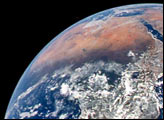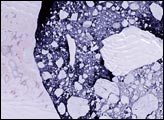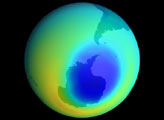Coupled Atmosphere - Ocean Interactions



Ideas for Project
-
The Strength of the Hadley Circulation:
Without the eddy transport of momentum, a Hadely circulation that is centered (driven)
about the equator has several unreaslitic features. Most notable are the too strong jets,
the very weak surface winds and overturning circulation.
I class, I showed that an aqua planet simulation that allowed eddies provided a solution that was qualitatively different from the no-eddy solution, with the former providing a zonal mean and Hadley circulation that compares favorably to the observations. The solution was symmetric about the equator: that is, the rising branch of the Hadley cell is on the equator.
There is another way to get a strong Hadley circulation without having to worry about eddies. James (1994) summarizes the work of Lindzen and Hou, who argued that a Hadley circulation that has it's upward branch off the equator would not have these deficiencies, vis a vis the observed circulation. The upward branch (the ITCZ) of the Hadley cell is indeed usually found off the equator (into the summer hemisphere).
This raises a fundamental question that has not been asked in the literature. Which is more important for understanding the zonally averaged circulation of the tropics: the eddies or the annual cycle?
- Mixing and the down fall of a warm ENSO event? Was the profoundly rapid shutdown of the 1997-98 ENSO event ( 125 West, 0N and 140 West, 0N ) due to an abrupt mixing event that came about because (A) of a highly nonlinear relationship between the efficiency of entrainment, the strength of the wind and the slope and shear of the equatorial undercurrent (with the latter two changing realively slowly compared to the turbulent mixing)? While "A" has been demonstrated in the laboratory for the non-rotating case of a tilted jet in a stratified shear, it has not been examined in a geophysical setting. This might be a fun project, that would involve Prof. Bob Breidenthal from Aeronautics and Astronautics.
- Why is the amplitude of the seasonal cycle in SST in the midlatitude oceans 2-3 times greater in the northern hemisphere than in the southern hemisphere? In class, we hypothesized that the answer involved land: there is much more in the northern hemisphere than in the southern hemisphere. We discussed three effects: seasonality in mixed layer depth (due to seaonality in storminess), the differential heat capacity of land and upper ocean (in the face of advection by the ubiquitous westerlies), and seaonality in the ocean heat transport. Which of these three effects are important? Does the answer give you any insight on the processes that are likely to be most important for climate variability ?
- The width of the equatorial cold tongues: Equatorial upwelling is thought to be confined to well within 100 km from the equator. The equatorial cold tongue is much wider than this (extending about 500 km from the equator). What sets the width of the cold tongue to the north and south of the equator? Is it wind stress curl? Is it ocean instabilities?
- Why is there no cold tongue in the Indian Ocean? On the face of it, one could argue that there are no mean Trade Winds to set up an east-west tilt. More specifically, there is no cold tongue because of the synergy of two facts: the amplitude of the annual cycle in the Trade Wind is larger than the climatological mean Trade Wind amplitude, and the seasonal cycle of winds is too short of a period compared to the ocean adjustment time. Another possiblity: the mean Indoneasian Throughflow keeps the mean themocline too deep along the equator to creat a cold tongue. Which of these factors is more important? What would it take to get an Indian Ocean cold tongue (and, thus, an ENSO-like mode in the Indian Ocean)?
- Why is the cold tongue in the equatorial Pacific found in the July-October season? That is, what sets the phasing of the annual cylce in the tropical Pacific?
- TBA
Last
Updated:
04/6/2001